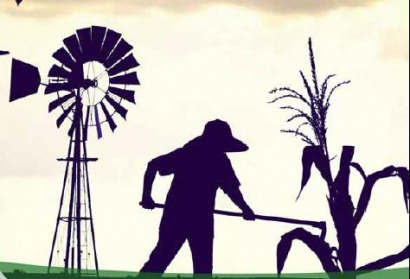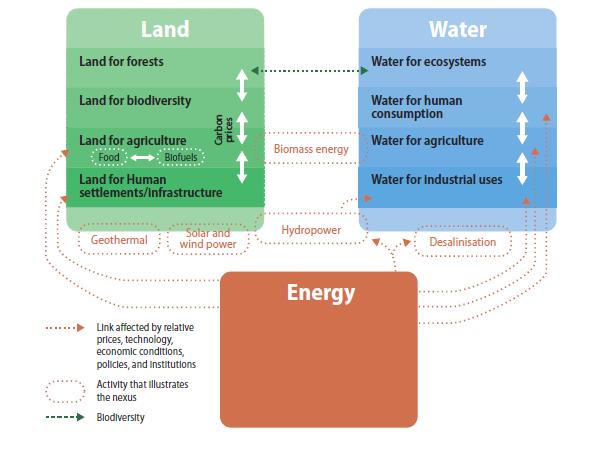
Launched last week in Brussels, the 2012 European Report on Development highlights predicted increases in the scarcity of natural resources – with demand for water and energy expected to rise by 40% and demand for food by 50% before we reach 2030.
“An adequate response to emerging challenges, and specifically the linkages between water, energy and land, make it imperative to examine and manage the trade-offs not only among users and uses of the same resource, but also of other related resources,” say the report’s authors. “A drop of water, a piece of land, or a kilojoule of renewable energy cannot be seen through the single lens of one sectoral policy or management system. What might appear to be an efficient policy in one dimension can be harmful for the others, and different ways of exploiting water and land or producing renewable energy place different stresses on the other resources.”
They warn that unless action is taken to confront these pressures, there will be considerable costs and missed opportunities. Environmental stresses (e.g. in water) affect women and girls disproportionally, lack of energy services is a binding constraint to economic growth, and the poorest are frequent losers from large scale land deals.
The 2012 European Report on Development introduces the concept of the water, energy and land nexus (the WEL nexus) as crucial to tackling these challenges in an integrated way. It also highlights a four pronged approach towards achieving a growth path that is socially inclusive and environmentally sustainable:
“Whilst global income poverty halved between 1990 and 2010, there are still close to a billon undernourished people, the same as 40 years ago. How can we feed 9.3 billion people sustainably by 2050? How can our planet deal with an expected increase by half in the amount of water, food and energy we consume over the next 20 years? How can we protect the poorest and most vulnerable countries and people that are frequent losers from the considerable environmental pressures on the planet’s resource?,” asks ODI’s Dr Dirk Willem te Velde, Team leader of the 2012 ERD. “What we have established is that countries need to avoid policy making in silos and stimulate integrated thinking that promotes the management of water, energy and land (WEL) as part of a WEL-nexus."
WEL nexus

Source: 2012 European Report on Development
The solution must include public and private actors according to Dr te Velde: “The public sector co-ordinates, regulates and taxes and spends. It needs leadership, capacities and the right political incentives to set economies onto a transformative path along the four pronged approach. The private sector dependent on quality natural resources will increasingly see the value in providing access to resources and in making their business models more sustainable.”
Looking specifically at renewables, the report highlights that developing renewable energy can provide energy to the poorest while reducing carbon dioxide emissions for all. “Given that energy-related GhG emissions are rising while the atmosphere’s sink capacity is finite, the world needs to move from a high-carbon to a low-carbon path while still providing the required energy services for inclusive and sustainable growth. A key element of this transition is to increase the supply of renewable energy services and reduce the dependence on fossil fuels, first in the industrialised world, but also in developing countries,” it says.
The authors of the report also suggest that large emerging powers also have the scope to make major reductions in their GhG emissions, and that there may also be “unexploited opportunities” for investment in renewable energy in those low-income countries with a large potential for renewable supply. These countries, the report argues, could be helped to adopt a ‘green growth path’, e.g. using climate finance when renewable energy is not yet economically viable, or to supply green energy for high-income countries.
A triple win
The provision of renewable energy can be a ‘triple win’ in terms of economic, social and environmental outcomes, says the report. The adoption of effective policy packages (such as the removal of market failures on capital markets, start-up incentives to reduce high initial capital costs related to the production of alternative energy, interventions to reduce negative externalities from the introduction of renewable energy plants, an efficient administrative regulatory framework and complementary skills) can help to make renewable energy economically, environmentally and socially sustainable. Kenya, for example, produces a large proportion of its electricity from green sources (hydropower, geothermal), including energy provided by the private sector enabled by an appropriate regulatory framework.
In practice however, the authors of the report found that these apparently attractive options for promoting renewable energy may not be feasible because of conflicting interests across groups (e.g. the lobbying power of fossil-fuel producers may pose an obstacle to boosting the production of renewable energy), short-term economic considerations (e.g. a rise in the price of fossil fuels sways public opinion against the removal of subsidies) or the lack of the right processes (e.g. the lack of participation impedes finding the right compromises between ‘winners’ and ‘losers’).
Furthermore, renewable energy sources such as biofuels, biomass and hydropower depend on land and/or water, and therefore a large increase in the supply of renewable energy could place considerable pressures on the other resources in the WEL nexus. “This underscores the need to manage efficiency across the WEL resources, since an increased supply of renewable energy may create stresses on water and the environment – an important example of the WEL nexus. This is especially true of biofuels,” stresses the report.
In countries such as China and India, which have large populations and high economic growth, the stress on water and land from the production of hydropower and biofuels may be particularly severe, although in the case of water this relates more to changes in basin flow regimes (including trans-boundary) rather than consumptive use. Concrete actions that policy-makers could take to preserve water and land include creating incentives for rainwater harvesting, the use of marginal land for production or the adoption of agricultural practices such as intercropping as well as smaller, decentralised dams and mini-hydropower.
“The much-needed investment in renewable energy must also bring with it a commitment to deal with distortionary energy subsidies that contribute to the over-exploitation of water. In some countries, the intensive use of groundwater is fuelled by energy subsidies, bleeding the energy economy dry and contributing to the overuse of resources. Investing in energy supply (albeit renewable) without addressing the politically difficult question of demand management – with energy and water locked together – is unsustainable,” the report concludes.
Special emphasis on biofuels in the WEl nexus
Chapters 6 and 7 of ERD 2011/2012focus especially on biofuels and their interconnections with water and land use, finding that while biofuels have the potential to reduce the pressures on carbon space by reducing GhG emissions, they can impact on food and water security.
Biofuel feedstocks occupy some 2–3% of arable land worldwide. Since production is mostly in highly commercial agricultural areas, the impact on prices may be higher than the share in total area or production implies. Many factors such as oil prices, speculation and government interventions contributed to the 2008–09 spike in the price of food and the increases in biofuels may have raised food prices from between 5% and 20% in recent years.
Projections of future biofuel and food production indicate growing competition for land if all biofuel policies are fulfilled or if biofuels became economically viable without government support. Some suggest that biofuels could be responsible for 27% of world transport energy by 2050, and using 6% of the world’s arable land.
“Global biofuel feedstock production affects land-use change, land pressure and food prices, particularly if its production depends on large amounts of external inputs. The effects on poor people in developing countries and to ISG are mainly via food prices, which create positive incentives for net-producers and negative impacts for net-consumers,” says the report.
However, it does argue that the impact of biofuels on food production depends on “context-specific factors such as the land, technology and farming model used, and whether there is a spill-over to other crop production”. Some biofuels are also very water-intensive, and the average water footprint of biomass is 70 times bigger than that of oil. “The water footprint of biofuels (e.g. from ethanol) also varies widely across countries and contexts, which underlines the need to monitor the effects of biofuel production on water and land use,” it concludes, again highlighting why water, land and energy should not be considered in isolation, but as part of an interconnected system.
"This report is particularly relevant and timely ahead of the UN Rio+20 conference and in the International Year for Sustainable Energy for All. Water, energy and land are crucial resources for development and human well-being and scarcity cannot be overcome by piecemeal actions,” comments European Commissioner for Development Andris Piebalgs.
For additional information:
2012 European Report on Development

